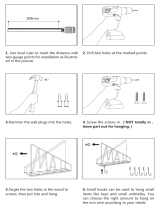
20
CARE & CLEANING
WARNING
• Never put your hand into the area housing the fan while the fan is
operating.
• Turn off power to the hood before cleaning.
• Make sure your cooktop and hood are cool before cleaning.
• Use only the types of cleaning solutions mentioned in this manual.
• Completely dry the filter(s) immediately after cleaning.
CLEANING EXTERIOR SURFACES
• Regular care will help preserve the appearance of your range hood.
•Always wipe stainless steel surfaces with the grain to avoid scratches
• Clean periodically with hot soapy water and clean cotton cloth.
• For heavier soil, use a liquid degreaser such as 409™ or Fantastic™.
• If hood looks splotchy, use a stainless steel cleaner on the surface.
Promptly and gently remove cleaner with a soft towel or wipe.
• After cleaning, you may use non-abrasive stainless steel polish (such
as 3m™ or ZEP™) to buff out stainless luster. Always scrub lightly and
with a clean cotton cloth.
DO NOT
• Use corrosive or abrasive detergent (eg, Comet Power Scrub™ or EZ-
Off™ oven cleaner).
• Use steel wool or scouring pads, which will scratch and damage the
stainless steel surface.
• Leak cleaning solution onto or into the control panel.
• Allow deposits to accumulate or remain on the hood.
• Allow salt solutions, disinfectants, bleaches, or cleaning compounds
to remain in contact with the stainless steel for extended periods.





















